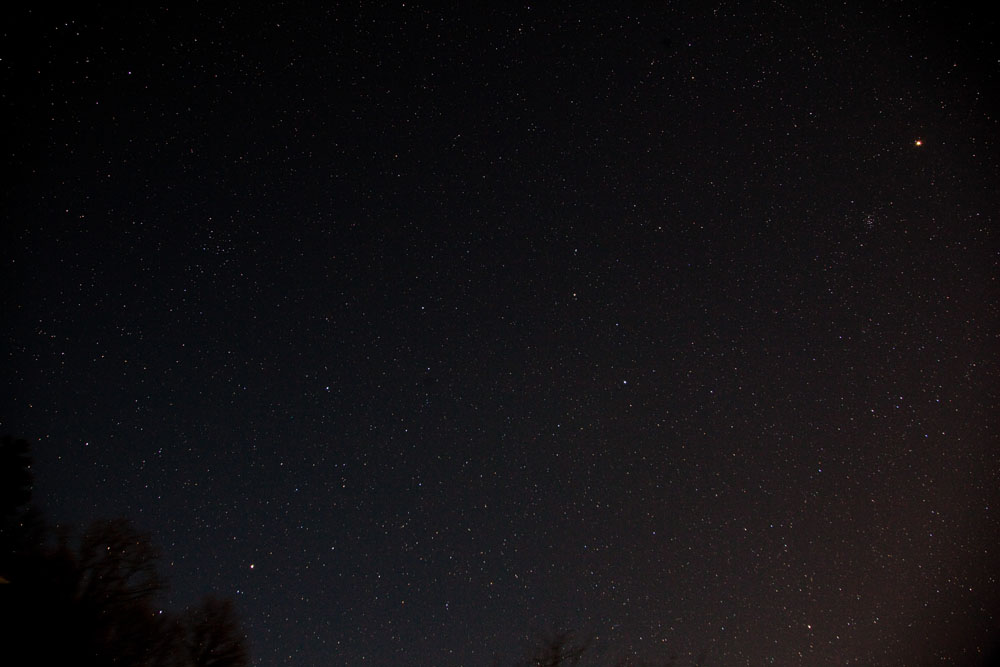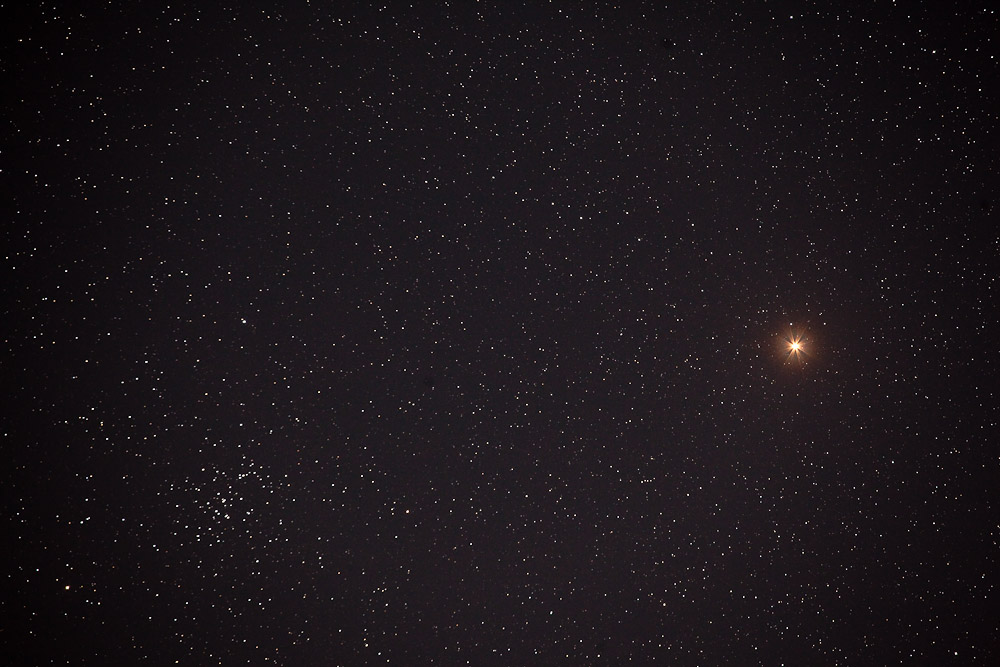Capturing Constellations
Introduction
If you expose the sky long enough, more stars become visible in the image. I assume here that active tracking is used to compensate for the Earth's rotation. The images on this page were taken using the Astrotrac travel mount. Long exposure not only results in a multitude of stars where constellations become less recognizable, but it also causes bright stars to be overexposed. This overexposure is not apparent in the photo since the overexposed area is very small. However, bright stars do not get brighter with increasing exposure because they are already fully exposed. On the other hand, darker stars become brighter with longer exposure until they reach their maximum exposure. This leads to the captured image not matching the visual impression of the starry sky. Additionally, the increasing local overexposure causes bright stars to lose their color and appear only white. However, visually, one can still perceive the colors of individual stars, especially for red giants like Betelgeuse in Orion (spectral class M, 2000-3350K, red-orange).
Diffuser
A solution to this issue is the use of diffusers or soft-focus filters. These filters slightly blur the entire image regardless of the object's distance, spreading the light hitting a point over a larger area. This dispersal reduces or eliminates local overexposure of stars. Furthermore, in the outer regions where less light is scattered, the color of the star is more intensively represented. This results in an image that corresponds to the visual impression. The downside of this method is that darker stars may not receive enough exposure due to the scattering of their light and may not be visible in the photo at all.
Double Exposure
However, there is a way to overcome this disadvantage. Simply take two exposures, one with a filter and one without, and then overlay the two images. Ensure that the filtered exposure has a darker surface brightness than the unfiltered exposure. This ensures that areas with good star representations in the unfiltered exposure are not overwhelmed by diffuse sky areas in the filtered exposure. Only the bright stars or their immediate surroundings are then brighter in the filtered exposure than in the other exposure. Overlay the two images, for example, in Photoshop, check the registration (upper layer at 50% transparency), and adjust it by moving the upper image if necessary. By the way, it doesn't matter which image is on top. What is crucial is that, in the blending method of the two layers, the upper layer is assigned the 'lighten' method. This ensures that only the brighter part of one exposure is incorporated into the composite, which is brighter than the same part in the other exposure.
Of course, you can optimize the exposure without a filter or reduce noise by capturing the same image multiple times and then averaging the images in a stacking program, such as DeepSkyStacker. The averaged exposure then serves as the base for the subsequent overlay with the filtered exposure. It is not necessary to perform multiple exposures with a filter since only the highlights are integrated into the image, and they are not noisy.
Comparison
Before we proceed to the images, I would like to share a few words about spectral classes. Approximately 99% of all stars fall into classes O, B, A, F, G, K, M. A useful mnemonic for remembering them is "Oh Be A Fine Girl Kiss Me" or "Offenbar Benutzen Astronomen Furchtbar Gerne Komische Merksätze." O is the class of the hottest and largest stars, hence the bluer stars, while M represents smaller, less hot, and yellower stars. Our sun belongs to class G. The temperature ranges for these classes are as follows:
O: 30,000-50,000K, B: 10,000-28,000K, A: 7,500-9,750K, F: 6,000-7,350K, G: 5,000-5,900K, K: 3,500-4,850K, M: 2,000-3,350K (these values are from this page)
Now, let's move on to the images.
In the image below, you can see the two stars Dubhe (left) and Alioth (right), forming the rear of the "Wagon" or "Big Dipper" (Ursa Major). While Dubhe appears almost neutral (spectral class F, so it should have a bit of a bluish tint), Alioth appears distinctly blue with a spectral class of A. The other image was taken without a filter, and no colors are visible (except perhaps small color fringes generated by the lens).


Examples
Cassiopeia
Cassiopeia (CAS), the "W" in the sky, is easily observable in the northern hemisphere. If you swing from the Big Dipper over the North Star, you can easily reach Cassiopeia. Schedir, in the image below on the right, is a star of spectral class K, like Aldebaran in Taurus or Arcturus in Boötes (see below, image of the Big Dipper). The coloration of Schedir contrasts beautifully with the other four stars forming the constellation lines. The other stars have the following spectral classes (from left to right: Segin: B2, Ruchbah: A5, Gamma: B0, Schedir: K0, Caph: F2). A (approx. 8000K) and B (approx. 15000K) are strongly blue, and F (approx. 6500K) is slightly blue (our sun is G, approx. 5500K).
By the way, on the bottom left of the image, you can clearly see the double star cluster H and Xsi (NGC869 and 884) in Perseus. On a clear night, you can also see these star clusters with the naked eye between the two constellations Perseus (a forked branch) and Cassiopeia. Both star clusters contain about 300 stars each! In this image, you may be able to recognize around 20 or 30 stars per cluster.

Stars |
Stars with Filter
|
Constellation |
Star Names |
Hover over the aperture number to display the corresponding image.
Little Dipper (Ursa Minor)
The Little Dipper or Ursa Minor is primarily known for its main star, Polaris, the North Star. Polaris, on the far left in the image, shines with spectral class F7, giving it a slight bluish tint. In contrast, Kochab on the right in the image has a spectral class of K4, similar to Shedir in Cassiopeia above and Arcturus in the image of the Big Dipper below.
In this image, you can also see why the North Star, along with the two stars forming the rear of the "Wagon," is easily visible in the sky, while the stars in between are not visible in poor visibility. While Polaris and Kochab shine with a brightness of 2.0 and 2.1 magnitudes, respectively, and Perkhad still has a brightness of 3.0, all other stars have brightnesses above 4. This is visible in the image without a filter, but not as clearly as in the overlaid image. By the way, the blue star in the bottom right of the image is already in Draco, which winds its way between the two wagons. It is likely Aldhibah, with a brightness of -1.9, similar to Perkhad and a spectral class of B6, not far from it in color.

Stars |
Stars with Filter
|
Constellation |
Star Names |
Hover over the aperture number to display the corresponding image.
Leo (Lion), Cancer, and Leo Minor (Little Lion)
If you return from Cassiopeia over the North Star to the Big Dipper and then continue scanning, you'll reach Leo, a beautiful constellation. The star at the bottom right is Regulus, the first star (alpha) in the constellation. It is almost precisely on the ecliptic, so Leo is frequently visited by planets. In this image, you can see two of them (ignoring the Earth): Saturn at the bottom left and Mars at the top right. Mars is already in Cancer, and its reddish color is enhanced by the filter. The stars that border the constellation lines of Leo almost all have a bluish color, except for Algieba at the beginning of the neck, which stands out with spectral class K0 (similar to Shedir in Cassiopeia and Kochab in the Little Dipper).
Just to the left of the farthest star, Denebola, is the Virgo Cluster in Virgo, a large galaxy cluster that extends up into Coma Berenices' hair. The many individual stars of the cluster are visible just above. Further up are the Hunting Dogs, another inconspicuous constellation, but an Eldorado for galaxy hunters (e.g., M51, the Whirlpool Galaxy).
The Little Lion shines rather inconspicuously above Leo, not standing out much next to its big brother. Directly above the Little Lion, Lynx appears on the right, and above that, the Big Dipper or Ursa Major.

Stars |
Stars with Filter
|
Constellation |
Star Names |
Hover over the aperture number to display the corresponding image.
Big Dipper, Ursa Major
The Big Dipper or Ursa Major is arguably the most well-known constellation, at least in the Northern Hemisphere. It is circumpolar, meaning it can be seen more or less throughout the year. The main star, Dubhe, stands out due to its more neutral color compared to the other blue stars. It has spectral class F7, making it still slightly bluer than our Sun. However, compared to the other blue stars, it appears slightly yellow. Dubhe is about equally bright as Alioth and Alkaid, which are A0 and B3 spectral classes, respectively, and significantly bluer.
Bluer stars are hotter (as indicated by their color temperature) and therefore emit more energy. Their temperature is also related to their size, so one can generally say that blue stars are also hot and, consequently, large stars. Because they emit more energy, they burn out faster, meaning they have a shorter lifespan than slowly 'burning' stars like our Sun.
At the bottom of the image, through the forest, shines the main star of the Herdsman or Boötes (Bootes), Arcturus. As mentioned earlier, it falls into the same group as Shedir in Cassiopeia and Kochab in the Little Dipper.
The blue star to the right of Alkaid is Cor Caroli in the Hunting Dogs. To the right of it are the many stars in the constellation Coma Berenices.

Stars |
Constellation |
Star Names |
Hover over the aperture number to display the corresponding image.
Manger in Cancer with Mars
The last image was taken without a filter. Since Mars already has a certain surface area and is very bright, it is depicted in color even without a filter. The star cluster at the bottom left is the Manger in the constellation Cancer. Incidentally, it is visible to the naked eye in the night sky. Cancer is a rather inconspicuous constellation, especially when flanked by prominent constellations like Orion and Leo. The Manger stands out more, and once you've spotted it, you're already in the heart of Cancer. However, in this image, it's noticeable that apart from Mars, no other object is depicted in color; all the stars appear white.
